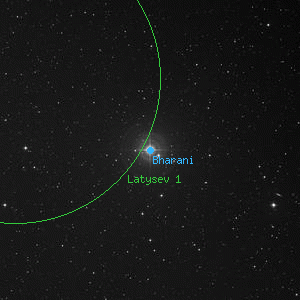Bharani

Overlaid DSS image of Bharani, 60' x 60' with north at top and west to the right
Aladin viewer for the region around Bharani
c Ari, 41 Arietis, 41 Ari
BD+26 471, HD 17573, HR 838, WDS J02500+2716A, SAO 75596, GSC 01789-01490, HIP 13209
BD+26 471, HD 17573, HR 838, WDS J02500+2716A, SAO 75596, GSC 01789-01490, HIP 13209
| Type | Multiple Star |
|---|---|
| Magnitude | 3.63 | Right Ascension | 2h 49' 59.0" (2000) |
| Declination | 27° 15' 38" N |
| Constellation | Aries |
| Description | Multiple A/D 3.59/8.68 122" 237° |
| Classification | B8Vn |
Observing Notes
Andrew Cooper
Feb 25, 2020 Waikoloa, HI (map)
20cm f/6 Newtonian, Cave Astrola @ 61x
Seeing: 7 Transparency: 7 Moon: 0%
Blue-white, several stars in close proximity but none are physically related, there is a companion but it is only 0.2" from the primary, actually the 3rd brightest star in Aries, but does not have a Bayer designation or even a proper name
Captain William Henry Smyth
Feb 6, 1834 No. 6 The Crescent, Bedford, England (map)
150mm f/17.6 refractor by Tully 1827
A coarse quadruple star, in the south wing of the Fly, and forming its lucida. A 3, white; B 13, deep blue; C 11, lurid; D 9, pale grey. Of these two members A and C form 116 H V. under these measures:Pos. 188°12' Dist. 39".37 Ep. 1782.98while A and D constitute 5 ♅ 6, thus measured by H. and S.:
[WDS 235° 27".70 2014 ]Pos. 226°36' Dist. 127".55 Ep. 1821.96But since Sir William Herschel registered this object as 35 Arietis, and another error of identity occurred, it should be stated that A is 186 P. II., the Muscæ secundæ</a> of the Palermo Catalogue; and to which is assigned the following degree of proper motion, viz.:
[WDS 237° 122".30 2014 ]P.... RA +0".20 Dec. -0".14My friend the Rev. Mr. Dawes re-examined this object at my request in October, 1842, with results very similar to my own, —whence the difference between H. and myself in the angle of A and C must be only accidental. Piazzi's note 186 to Hora II., mentions a couple of distant companions—utraque 9æ magnit.—which, though too far off to be very interesting, may be thus reduced:
B.... +0".09 -0".10
[Hipparcos +0".06681 -0".11652]1 Pos. 275°.6 Dist. 94" Ep. 1800Musca Borealis is a little asterism to the north-east of the Ram's head, and is known by three stars of the 3rd and 4th magnitudes. It seems to have been composed from informes</a> by Bartschius, the scientific son-in-law of Kepler; for which reason, perhaps, it was afterwards retained by Hevelius, though reluctantly. To identify the object here treated, let a line from Aldebaran be passed under the Pleiades and meet another carried from α Andromedæ over α Trianguli; it will pass Lucida Muscæ in the mid-distance.
2 213°.5 146"― A Cycle of Celestial Objects Vol II, The Bedford Catalogue, William Henry Smyth, 1844
Other Data Sources for Bharani
Nearby objects for Bharani
6 objects found within 120'
| 35 Arietis | HCG 20 | IC 1861 |
| Latysev 1 | Lilii Borea | NGC 1056 |
Credits...
Drawings, descriptions, and CCD photos are copyright Andrew Cooper unless otherwise noted, no usage without permission.
A complete list of credits and sources can be found on the about page
Bharani